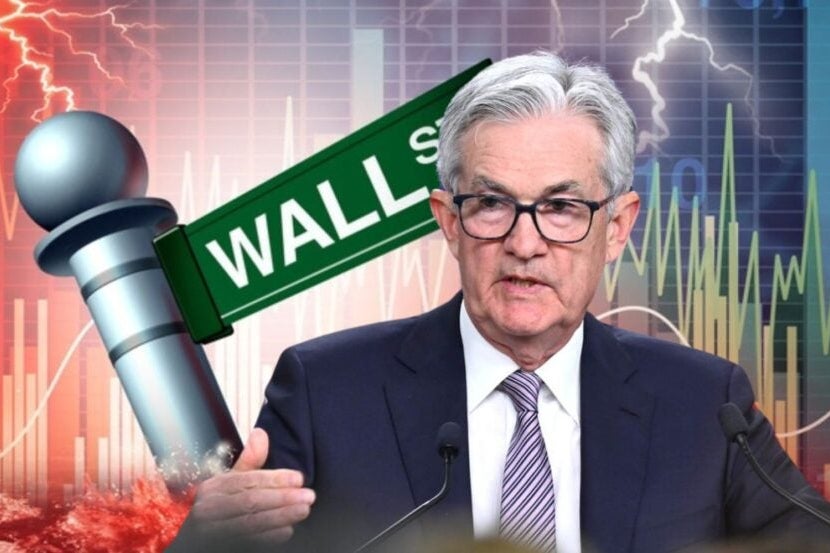Powell Says It’s ‘Too Soon To Say’ On Rates As Tariffs ‘Likely To Raise Inflation’ – Invesco QQQ Trust, Series 1 (NASDAQ:QQQ), SPDR S&P 500 (ARCA:SPY)

Federal Reserve Chair Jerome Powell signaled a cautious policy stance on Friday, hinting that slowing economic momentum is not yet enough to ease the Federal Reserve’s inflation concerns, as higher tariffs threaten to complicate the path toward price stability.
Speaking at the Society for Advancing Business Editing and Writing conference, Powell said the economy is still “in a good place,” but acknowledged that growing uncertainty tied to trade and regulatory changes has raised the risk of both slower growth and rising inflation.
Just minutes before Powell took the stage, President Donald Trump took to Truth Social, urging the Fed chair to act swiftly: “This would be a perfect time for Fed Chairman Jerome Powell to cut Interest Rates. He is always ‘late,’ but he could now change his image, and quickly.”
Trump claimed that energy prices, interest rates, and inflation have all declined—highlighting that even egg prices have dropped 69%—while job growth has surged in just two months, calling it “a big win for America.”
Fed Faces New Trade-Induced Inflation Pressures
While Powell reaffirmed the Fed’s commitment to its dual mandate—maximum employment and stable prices—he didn’t shy away from addressing the challenge posed by rising tariffs.
He said the increases will likely be “significantly larger than expected” and warned that “higher tariffs will be working their way through our economy and are likely to raise inflation in coming quarters.”
After falling from the pandemic highs of 2022, price pressures are proving stickier. Data from February show that total Personal Consumption Expenditures (PCE) inflation rose 2.5% year-over-year, while the core measure, which excludes volatile food and energy categories, climbed 2.8%. These levels remain above the Fed’s 2% target.
Though long-term inflation expectations remain “well anchored,” Powell said both survey-based and market-based measures of near-term inflation expectations have “moved up.”
The Fed, he added, is closely watching this development.
Job Market Still Strong, But Growth Slows
The U.S. labor market continues to show resilience. March’s jobs report showed the unemployment rate at 4.2%, in line with its average since early 2024.
Over the first quarter, payrolls increased by an average of 150,000 jobs per month. The Fed views this as a sign of a labor market that is “broadly in balance” and “not a significant source of inflationary pressure.”
Powell acknowledged that “many forecasters have anticipated somewhat slower growth this year,” and that both hard and soft data reflect that shift.
While the initial estimate for first-quarter GDP is still pending, early indicators align with expectations for a deceleration. At the same time, business and household surveys show a notable uptick in pessimism, driven largely by policy uncertainty.
Fed Signals Patience Amid Uncertainty
“It is too soon to say what will be the appropriate path for monetary policy,” Powell said.
“We face a highly uncertain outlook with elevated risks of both higher unemployment and higher inflation.” he added.
The outlook is complicated by uncertainty over tariff details, including which goods will be taxed, at what rates, for how long, and the potential response from trading partners.
Powell said the size and duration of tariff-related inflation “remain uncertain,” and warned of the possibility that temporary price increases could become more persistent.
The Fed’s challenge, he noted, is to ensure “a one-time increase in the price level does not become an ongoing inflation problem.”
“We are well positioned to wait for greater clarity before considering any adjustments to our policy stance.”
Rate Cuts? Not So Fast
The message for markets was clear: The Fed is in wait-and-see mode. While investors began 2025 pricing in as many as four rate cuts, recent data and Powell’s comments suggest that dovish pivot may be postponed.
“It’s too soon to say what the appropriate monetary policy response would be to these policies,” Powell said.
Stocks fell in response to Powell’s remarks. The S&P 500 index – as tracked by the SPDR S&P 500 ETF Trust SPY – was 4.2% lower by 11:35 a.m. ET.
The Nasdaq 100 – as tracked by the Invesco QQQ Trust QQQ – tumbled 4.3%.
Read now:
Image created using photos from Shutterstock.
© 2025 Benzinga.com. Benzinga does not provide investment advice. All rights reserved.




